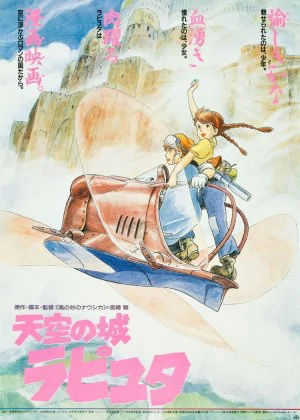Laputa: Castle in the Sky
Laputa: Castle in the Sky [Tenkû no Shiro Rapyuta] must've been one of the first Ghibli film I've seen, back then it was a perfect introduction into the work of Hayao Miyazaki. It's an amalgam of what makes Miyazaki's films so special, blending adventure and fantasy elements with powerful and memorable characters, beautiful settings and tons of creativity. It's been more than 15 years since I last watched it though and things move fast in the animation industry, so I was quite curious to see whether it still held up after all this time.
![screen capture of Laputa: Castle in the Sky [Tenkû no Shiro Rapyuta]](/thumbs/img/articles/1200xauto/laputa-1.webp)
Even though Nausicaä marks the official start of Studio Ghibli, I feel it's Laputa that really captured the trademark Ghibli spirit for the first time. Nausicaä was a rather bitter film, with surprisingly grim scenes and an aggressively focused eco-themed plot. Laputa managed to retain some of that darkness, but didn't allow it to overwhelm the film, so the result is a lot more upbeat and heart-warming. In Laputa Miyazaki found a better balance between entertainment, wonder and social critique, creating a much smoother overall experience that would come to define the next 30 years of Ghibli entertainment.
Though Ghibli became a major force in the anime industry, Laputa might have had an even bigger influence on the Japanese gaming world. Fans of JRPGs will feel right at home here, as early entries in the Final Fantasy and Dragon Warrior franchises copied a lot from the Laputa universe. If you've played these early JRPGs, you'll immediately recognize the floating islands, the airships and magical tech that helped these games stand out from its Western counterparts. While I'm not saying Miyazaki created these words all by himself, I have no doubt Laputa is one of the prime reasons why these universes became so popular in Japan.
The story revolves around Sheeta, a young girl who is chased down by both the military and a group of pirates. In a struggle Sheeta falls from an airship and crashes down. Before she hits the ground though, she is saved by a penchant she's wearing. Pazu, a young boy who works in the mines, finds Sheeta and decides to take care of her, but it doesn't take long before the pirates are back on their heels. Sheeta and Pazu manage to flee and begin a journey to find out what powers the penchant houses, but it won't be easy to stay out of the grasp of their many adversaries.
![screen capture of Laputa: Castle in the Sky [Tenkû no Shiro Rapyuta]](/thumbs/img/articles/1200xauto/laputa-2.webp)
Miyazaki is best known for his consistent, subtle and detailed animation. Laputa wasn't quite there yet, but you can clearly see the blueprint for Miyazaki's later films. The difference in character and background drawing styles is still quite substantial here, but that wasn't uncommon in 80s anime. Backgrounds are somewhat sketchier, relatively low in detail but still rich and beautiful, whereas the character art is a lot cleaner, though simpler. These two styles work well together, but it's not as consistent as you might expect from a Ghibli film. Luckily the world of Laputa looks amazing, with very cool tech designs (the airships in particular are lovely and the robots are iconic), beautiful towns and mysterious floating islands. The character animation also stands out, with small poses and gestures that give the characters lots of depth and personality. Laputa may be 35 years old, but it's still a looker.
The music too is on point, with Joe Hisaishi providing a warm, comfortable and slightly subdued score. It's not quite as loud and in your face as you might expect from a score for a fantasy film, but that's a large part of the appeal here. While rather epic in scope, the film is actually very calm and dreamy, with plenty of time to enjoy the smaller pleasures of adventuring. The score reflects that perfectly. As for the dubbing, normal recommendations apply. The Japanese dub is fun and distinctive, providing plenty of personality to the characters, the US dub on the other hand is flat and grating in comparison. You have been warned.
![screen capture of Laputa: Castle in the Sky [Tenkû no Shiro Rapyuta]](/thumbs/img/articles/1200xauto/laputa-3.webp)
Laputa has a lot to offer, for me personally though it's the deliberate pacing that made the biggest impact. Miyazaki doesn't let his film be defined by more traditional fantasy build-ups, best exemplified by the scenes where Sheeta ad Pazu finally reach the floating island. This happens about 90 minutes in, usually a time when the pre-finale build-up is well underway. But Miyazaki doesn't mind slowing things down and gives his audience ample time to discover the island and revel in its beauty. It's a period of tranquility, discovery and wonder you'll rarely find so late in a film, but it's by far one of Laputa's most beautiful sequences.
It's only normal Laputa has aged a little, after all the film was made almost 35 years ago. The animation business has changed a lot between then and now, even so Miyazaki's film still stands proud. The sense of adventure, wonder and delight is what set this film apart, combined with a great eye for detail and perfect pacing it makes for a sprawling, joyous fantasy film. It's not Miyazaki's ultimate masterpiece, but it's a confident and powerful step forward that would foreshadow his dominance in the animation scene. A must if you haven't seen it already.
